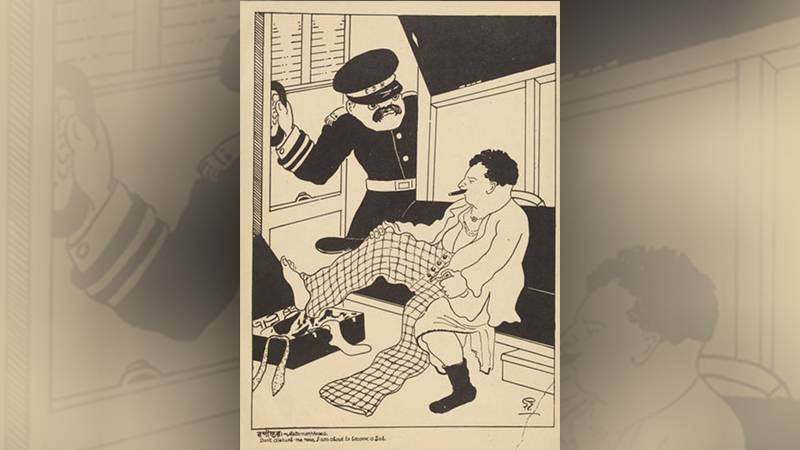
In this image, printed in ink on paper in 1917 in Kolkata, an Indian man sits in a train carriage and is getting changed into his western clothes. A train guard is about to enter the carriage. In colonial India train carriages were racially divided and train guards were usually of Anglo-Indian descent. These often discriminated against native Indians. Here, the train guard has caught the native Indian trying to change his identity. The subtitle reads: “Don’t come into the room, I am about to become a sab.”
This is from a collection of 16 lithographs bound in one volume. The lithographs are a series of caricatures of Bengali life, depicting the artist’s satirical comments on a range of subjects including the caste system, the hypocrisy of Hindu priests and the double-standards of the affluent western-educated members of society known as the Bhadralok.
Gaganendranath Tagore (1867-1938) was a satirical cartoonist and painter. Born in Calcutta, Gaganendranath grew up in a family whose exceptional creativity spearheaded Calcutta’s cultural scene. Gaganendranath was the nephew of poet Rabindranath Tagore and brother of Abanindranath Tagore, the pioneer and leading exponent of the Bengal School of Art.
The artist received no formal education but was trained under the British school water colourist Harinarayan Bandopadhyay. In 1907, he founded the Indian Society of Oriental Art with his brother Abanindranath. Between 1906 and 1910, the artist assimilated the Japanese brush technique and Far Eastern pictorial conventions into his own work. From 1910 until 1914, Gaganendranath developed his own approach to SUMI-E or black ink. Between 1915 and 1919, the artist, with the help of his brother, set up the Bichitra club in the Tagore family house. The club served as an important social, intellectual and artistic hub of cultural life in Calcutta, where many artists, including Nandalal Bose, A.K. Haldar and Suren Kar worked at their paintings.
During these years, Gaganendranath abandoned the ideological revivalism embraced by the Bengal School of Art and took up caricature to satirize the westernised middle class of urban Bengal. The artist’s popularity was secured in 1917 when Modern Review published many of his shrewd cartoons. From 1917 onwards, his lithographs appeared in a series of books, including: Play of Opposites, Realm of the Absurd and Reform Screams. In these mocking pieces, the austerity of Kalighat paintings is wedded to the simplicity of Japanese prints. Between 1920 until 1925, Gaganendranath, informed about modern European art, pioneered experiments in cubism colour and in ink. His work however, was pictorially closer to the dynamism of Italian Futurism rather than the work of Picasso and Braque. From 1925 onwards, the artist developed a complex post-cubist style. Gaganendranath’s work has been exhibited internationally.
In this series of caricatures, the artist wanted to highlight the nature of society in India at a time when the struggle for Indian Independence from British rule was just beginning. He wanted to expose the hypocrisy of the Hindu priesthood as well as the rich westernised Indians who had lost sight of the value of their own culture. This album was printed in small quantities and was sold for four rupees.
This is from a collection of 16 lithographs bound in one volume. The lithographs are a series of caricatures of Bengali life, depicting the artist’s satirical comments on a range of subjects including the caste system, the hypocrisy of Hindu priests and the double-standards of the affluent western-educated members of society known as the Bhadralok.
Gaganendranath Tagore (1867-1938) was a satirical cartoonist and painter. Born in Calcutta, Gaganendranath grew up in a family whose exceptional creativity spearheaded Calcutta’s cultural scene. Gaganendranath was the nephew of poet Rabindranath Tagore and brother of Abanindranath Tagore, the pioneer and leading exponent of the Bengal School of Art.
The artist received no formal education but was trained under the British school water colourist Harinarayan Bandopadhyay. In 1907, he founded the Indian Society of Oriental Art with his brother Abanindranath. Between 1906 and 1910, the artist assimilated the Japanese brush technique and Far Eastern pictorial conventions into his own work. From 1910 until 1914, Gaganendranath developed his own approach to SUMI-E or black ink. Between 1915 and 1919, the artist, with the help of his brother, set up the Bichitra club in the Tagore family house. The club served as an important social, intellectual and artistic hub of cultural life in Calcutta, where many artists, including Nandalal Bose, A.K. Haldar and Suren Kar worked at their paintings.
During these years, Gaganendranath abandoned the ideological revivalism embraced by the Bengal School of Art and took up caricature to satirize the westernised middle class of urban Bengal. The artist’s popularity was secured in 1917 when Modern Review published many of his shrewd cartoons. From 1917 onwards, his lithographs appeared in a series of books, including: Play of Opposites, Realm of the Absurd and Reform Screams. In these mocking pieces, the austerity of Kalighat paintings is wedded to the simplicity of Japanese prints. Between 1920 until 1925, Gaganendranath, informed about modern European art, pioneered experiments in cubism colour and in ink. His work however, was pictorially closer to the dynamism of Italian Futurism rather than the work of Picasso and Braque. From 1925 onwards, the artist developed a complex post-cubist style. Gaganendranath’s work has been exhibited internationally.
In this series of caricatures, the artist wanted to highlight the nature of society in India at a time when the struggle for Indian Independence from British rule was just beginning. He wanted to expose the hypocrisy of the Hindu priesthood as well as the rich westernised Indians who had lost sight of the value of their own culture. This album was printed in small quantities and was sold for four rupees.

